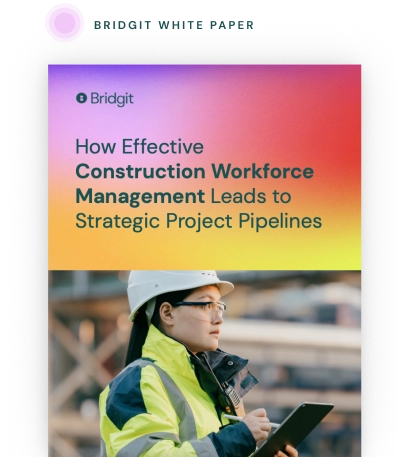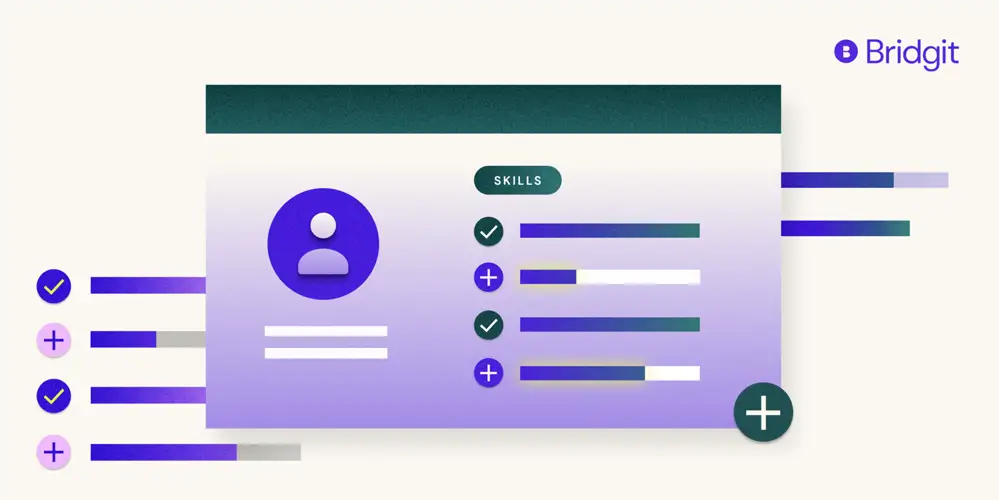Bracing for a recession comes with some obvious actions from employers across all industries, not just construction. We’ve seen it play out before: tightening budgets, reduced spending, and layoffs in order to stay afloat. We’ve covered how we expect the economic downturn to affect the construction industry and the results are confusing at best.
Table of Contents
However, we can predict with a reasonable degree of accuracy that there will be a buffer period between the economic hit and the time the construction industry feels it. This is mostly due to a strong project backlog. So we may feel the brunt of the recession’s effects in 2024 and 2025.
For the shrewd-minded, confusion and a possible buffer provide an opportunity. This opportunity arises from the central theme of recessions for businesses; trying to grow with fewer resources. In construction, the primary resource is people, since they’re the driving force behind all phases of project delivery, and they come with the largest price tag.
The question becomes, how do you get more productivity from a single person? A traditional answer to this would be something like driving the person with bigger expectations and having them work more hours. This is simply unsustainable because it’s inefficient and people aren’t machines (which also break down). With the added pressure from a squeezed economy, this approach is a recipe for burnout, resignation, or even mental health issues.

Use your workforce data to create a competitive advantage
Download our white paper to see how effective workforce planning can help stay ahead of labor demands and create a strategic project pipeline.
Imagine this: your workforce is a bunch of campfires in the dark, its light extends out to a certain point into the darkness before it gets lost in it. This is representative of the amount of work your workforce can get done before it simply can’t produce anymore.
So how do you extend the light? By adding more campfires, of course. But we can’t do that because economic conditions won’t allow us to hire. The other option is to make the fires bigger by adding more fuel to them. That fuel is your team’s skills. You can have your people achieve more with less when they upskill and reskill their talents to efficiently and effectively handle more work because they have the competence to.
Upskilling and reskilling have to be a part of your culture
Just like being data-driven as a company has to come from the top down in order to become a part of your firm’s culture, so does the focus on expanding your people’s skill sets. When you hire new employees it should be understood quickly that they have avenues for growth, and they can seek out new project experience and general job training.
In order to implement this culture your operations team and HR team need to evaluate how your people gain experience today, and how their development arc works within the present conditions. You may find that employee skills grow up to a certain level then stay stagnant, certain positions people start in may grow more than others, certain positions are asked to wear multiple hats when the pressure of deadlines starts to increase, or people grow up to a point and leave your company.
The answer to this is dependent on the context of your company and its history and processes.
Systematize your data and find the gaps
After you’ve made the current context of workforce development at your company clear, the next step is to get context on the individuals in the firm. To do this you need rich, up-to-date data that construction workforce management tools can provide.
In a tool like Bridgit Bench, you’re able to create a profile for each person working in your company. You can customize the information for what you want to see about each individual. For many companies, this includes project history, current projects, location, phone number, and upcoming vacations.
While these things are useful to track, you can also take a more robust approach and use these profiles as tools for employee development. You can track skills, the type of projects people worked on, certifications (you can also see when they’re expiring proactively), the people they worked well with, any goals the employee has, etc. Essentially anything you can think of that would provide context for an individual’s development can be recorded in a field.
Once this data is inputted and consistently updated, you’ll have the context to provide the resources and training so your people can expand their skill sets, careers, and overall knowledge.
Create a development initiative
The next step is the culmination of the steps you’ve taken thus far. All the data and the development gaps you want to fill will have the context needed to create an upskilling initiative throughout your company.
Of course, this is more difficult than it seems, it takes a lot of focused effort to create and nurture a culture of development in a company. One of the difficult things to figure out is how the learning and training will get done in the first place. Ryan Companies has taken the time to try and figure out the answer to this question.
They broke down their learning into three pillars:
- Professional development.
- Offering teaching in leadership, management, as well as personal skill development
- Understanding business operations.
- Inviting business leaders throughout the year for Q&As on what they’ve learned, how to be more efficient, and strategies for reaching goals and objectives.
- The culmination of learning in a project.
- They’re given a project early on that they have to research and solve and make a recommendation. They’re projects that are deemed essential and at the end of the year, then they present as teams to company leadership with their recommendations.
Ryan Companies also encourages employees to make peer groups within the company. Having an internal network of relationships helps people grasp all the different roles, responsibilities, and skills at a company. With these relationships, people can take responsibility for their own development and cross-train others in their roles.
With today’s technology and our ability to extend communication digitally, learning doesn’t necessarily have to be in person. You should be exploring a variety of learning modalities that range from online learning to direct communication on the job site. You’re not beholden to developing in one place, not to mention people have different learning styles so offering a variety of training methods can invite people who would otherwise shy away from a certain type of training.
In a recession, it’s inevitable that you’ll have to react to market conditions at the moment. It’s what you focus on after the initial reaction that’ll determine how your company performs long-term. Use this time to understand the trends happening in the industry and understand that enabling your workforce to develop and upskill will ultimately help you complete projects more effectively as well as make your company an appealing place to work.
Think your workforce planning meetings could be more productive?
Download our ebook to learn how to run efficient, effective workforce planning meetings with your team.



